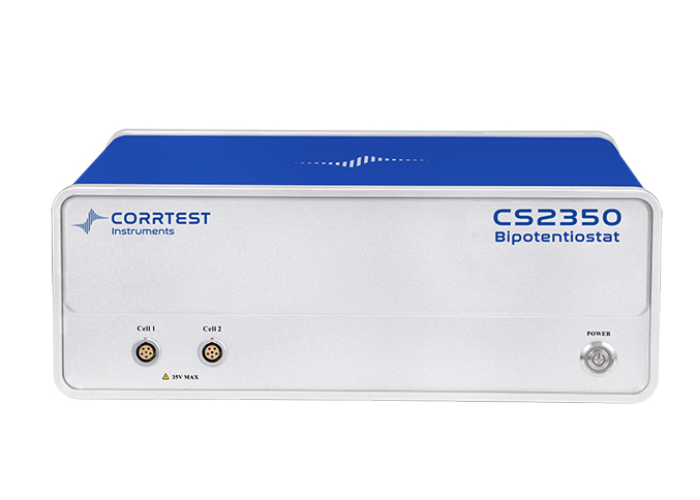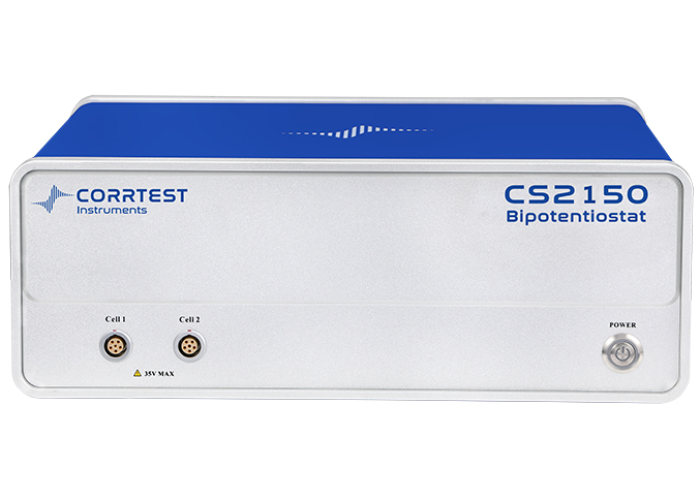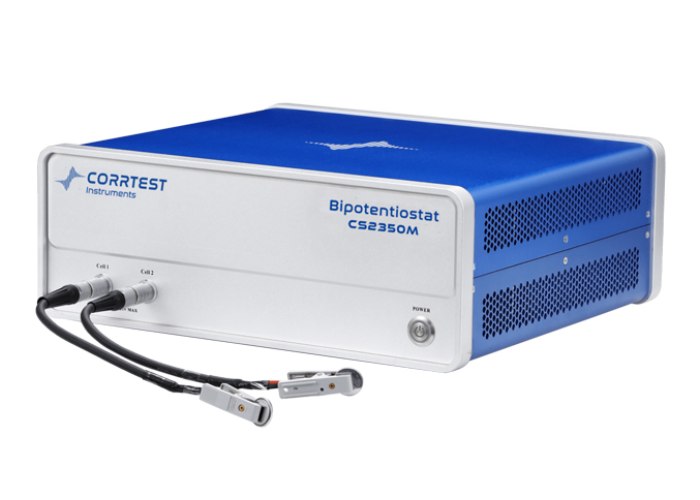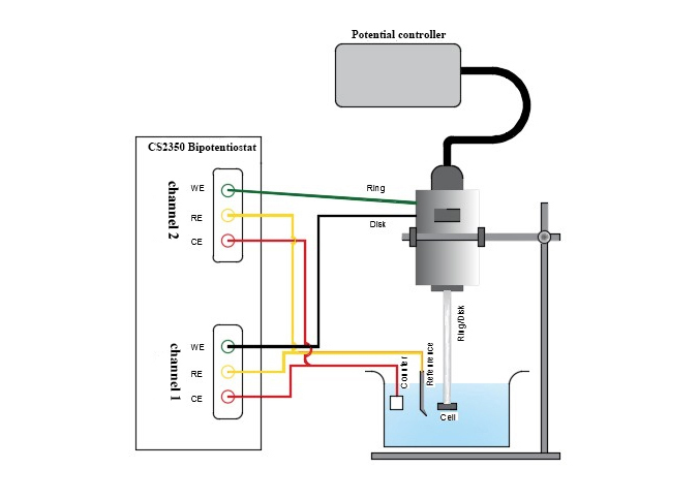
CS2350M Bipotentiostat (2-channel, with EIS)
2-Channel potentiostat with EIS in each channel
CS2350M Bipotentiostat (2-channel, with EIS) Highlights
The CS2350M is a dual-channel potentiostat/galvanostat system, purpose-built for advanced electrochemical research. Each channel is fully independent and includes its own EIS module, enabling true simultaneous measurements or coordinated dual-working electrode experiments such as RRDE or hydrogen diffusion studies.
Its Ethernet connectivity ensures stable high-speed data transfer, and the software is engineered for intuitive setup and advanced data analysis. Designed for researchers requiring flexible, powerful, and affordable electrochemical instrumentation, the CS2350M offers exceptional value at a fraction of the cost of comparable systems.
Key Features
- True 2-channel design with complete electrical separation
- EIS capability in both channels for full-spectrum impedance analysis
- Compatible with any commercial RRDE rotator system
- Enables hydrogen diffusion testing with H-cell configurations
- Full channel independence allows simultaneous experiments on separate cells
- Floating mode support for autoclave and in-ground electrochemical monitoring
- Cost-effective with high-end functionality
Applications
- Electrosynthesis, electrodeposition, electroplating, electrolysis
- ORR, OER, HER, CO₂ reduction studies
- Lithium-ion battery, fuel cell, solar cell, supercapacitor research
- Advanced material characterization and sensor development
- Corrosion evaluation and inhibitor screening
- Water treatment, coating stability, cathodic protection testing
Included Items
- CS2350M Bipotentiostat unit ×1
- CS Studio software ×1
- Power cable ×1
- Ethernet cable ×1
- Cell cables ×4
- Dummy cells (1kΩ||100µF) ×2
Highlighted Techniques
- Rotating Ring-Disk Electrode (RRDE): Enables intermediate detection at the ring while controlling disk polarization, ideal for ORR studies.
- Hydrogen Diffusion Test (HDT): Supports H-cell measurements for evaluating hydrogen permeation through metal surfaces.
- Electrochemical Impedance Spectroscopy (EIS): Uses advanced algorithms for high-resolution impedance analysis, even in high-resistance systems.
- Voltammetry: Full suite including CV, LSV, SWV, DPV, NPV, SCV, stripping voltammetry with integrated peak analysis tools.
- Polarization Curves: Automatic Tafel fitting for evaluating corrosion characteristics and inhibitor efficiency.
- Electrochemical Noise: For localized corrosion studies such as pitting, crevice, and stress corrosion.
Software Capabilities
- Peak analysis (area, height, position) for CV and other voltammetry techniques
- Cycle-by-cycle view and export for in-depth review
- Butler-Volmer equation fitting for Tafel and corrosion parameters
- Battery test analytics (capacity, charge/discharge energy and efficiency)
- Real-time data saving with automatic recovery after power loss
- Batch automation via combination test sequences
- SDK/API available for custom method integration
Hydrogen Diffusion Test (HDT)
The CS2350M bipotentiostat can be used in conjunction with H-cells to measure the current associated with hydrogen charging at the cathode and hydrogen atom oxidation at the anode. This setup enables the calculation of the hydrogen diffusion coefficient in metals and the measurement of hydrogen flux.
Technical Advantages
1. Impedance (EIS)
The Corrtest potentiostat utilizes a correlation integral algorithm along with a dual-channel over-sampling technique, providing robust resistance to interference. This makes it highly effective for EIS measurements in high-impedance systems (>10⁹Ω), such as coatings, concrete, and similar materials.
EIS of AA6063 Al alloy in Ce3+ containing 3% NaCl solution
2. Polarization Curve
A Tafel plot can be generated, allowing users to set the anodic reversal current (the current at which the passivation film breaks down) on the cyclic polarization curve. This helps in determining the material's pitting potential and protection potential, which are crucial for evaluating its susceptibility to intergranular corrosion. The software employs non-linear fitting to analyze the polarization curve, providing a rapid assessment of the material's corrosion resistance and the effectiveness of inhibitors.
Polarization curve of Ti-based amorphous alloy & stainless steel in 3%NaCl solution
3. Voltammetry
The system supports various voltammetry techniques, including Linear Sweep Voltammetry (LSV), Cyclic Voltammetry (CV), Square Wave Voltammetry (SWV), Differential Pulse Voltammetry (DPV), Normal Pulse Voltammetry (NPV), Alternating Current Voltammetry (ACV), and Stripping Voltammetry. It also integrates the calculation of peak areas, peak currents, and standard curve analysis for comprehensive data evaluation.
LSV: mesoporous carbon material in 0.1M KOH CV of PPy supercapacitor in 0.5 mol/L H2SO4
4. Electrochemical Noise
The system utilizes a high-resistance follower and a zero-resistance ammeter to measure natural fluctuations in potential and current within corrosion systems. This technique is effective for studying various types of corrosion, including pitting, galvanic, crevice corrosion, and stress corrosion cracking. By calculating noise resistance and the pitting index, it enables detailed monitoring of localized corrosion.
5. Full Floating Measurement
The full-floating mode is designed for autoclave electrochemical measurements and for real-time corrosion monitoring of metallic components buried underground, such as rebar in concrete.
6. Software Development Kit (SDK)
We offer API functions and development examples to assist users with secondary development and custom measurements. A .dll file is also available for integration.
Software Features
Cyclic Voltammetry (CV):
The CS Studio software includes a comprehensive suite of tools for smoothing, differential processing, and integration. These tools enable users to calculate peak height, peak area, and peak potential from CV curves. During data analysis, users can select specific cycles to view, either individually or across multiple cycles. Additionally, data and vector graphs of selected cycles can be exported for further analysis.
Tafel Plot and Corrosion Rate
The CS Studio software features advanced non-linear fitting of the Butler-Volmer equation for analyzing polarization curves. It enables the calculation of key parameters such as the Tafel slope, corrosion current density, limiting current, polarization resistance, and corrosion rate. Additionally, it can compute power spectrum density, noise resistance, and noise spectrum resistance based on electrochemical noise measurements.
Battery Testing and Analysis
The system evaluates key battery performance parameters, including charge and discharge efficiency, capacity, specific capacitance, and charge/discharge energy.
EIS Analysis: Bode, Nyquist, Mott-Schottky Plots
The EIS data analysis includes a built-in fitting function that allows users to generate custom equivalent circuits based on the measured data.
Real-Time Data Saving
The system ensures that data is automatically saved, even in the event of a sudden power failure, preventing data loss.
Combination Test
The combination test feature streamlines the automation of experiments, saving valuable time. With this function, users can select multiple techniques, specify wait times, set start times, and define the number of cycles. Once configured, the system can automatically execute the chosen experiments without requiring manual oversight, allowing for efficient multi-experiment management. This function is particularly beneficial for researchers with numerous experiments to run, greatly improving productivity.
Data Access
Data files can be opened in text format using Notepad, or alternatively, they can be imported into Origin for further analysis.
Technical Specifications
Precision engineering for accurate measurements
| Electrode Configuration | 2-, 3-, or 4-electrode system |
|---|---|
| Compliance Voltage | ±21 V |
| Potential Range | ±10 V (customizable to ±12 V) |
| Current Range | ±1 A |
| Potential Resolution | 1 µV (≤10 Hz), 3 µV (>10 Hz) |
| Current Resolution | 1 pA |
| EIS Frequency Range | 10 µHz to 1 MHz |
| Bandwidth | 8-decade frequency range, auto/manual setting |
| Interface | Ethernet |
| Software | Windows 10/11 compatible |
| Dimensions | 36.5 cm × 30.5 cm × 16 cm |
| Weight | 8 kg |
Methods/Techniques
Want to learn more about these techniques?
Check out our Introduction to Electrochemical Techniques blog for an in-depth overview of their principles and applications.
Resources & Downloads
Everything you need to get started
CS2350M Bipotentiostat Brochure
CS2350M Bipotentiostat Brochure
Customer Reviews
Related Product
Explore our precision instruments designed for electrochemical research and energy applications

CS2150M Bipotentiostat (2-channel, No EIS)
- Support 2-, 3- or 4-electrode system: Interface: Ethernet
- Potential control range: Primary Channel: ±10V second Channel: ±10V: Current control range: ±1A for each channel

Multi-Function RRDE system
- Rotation Speed: 50–9800 rpm (closed-loop control, <0.1% deviation)
- Speed Control: Manual or via potentiostat (remote control)
- Spin Coating: Supported (with integrated spin functionality)
- Motor Type: High-precision DC servo motor (Japan import)
- Electrode Shaft: Adjustable (vertical/horizontal/inverted)
Still Wondering About Something?
Explore our FAQ for fast, clear answers to the most common questions—available 24/7.


